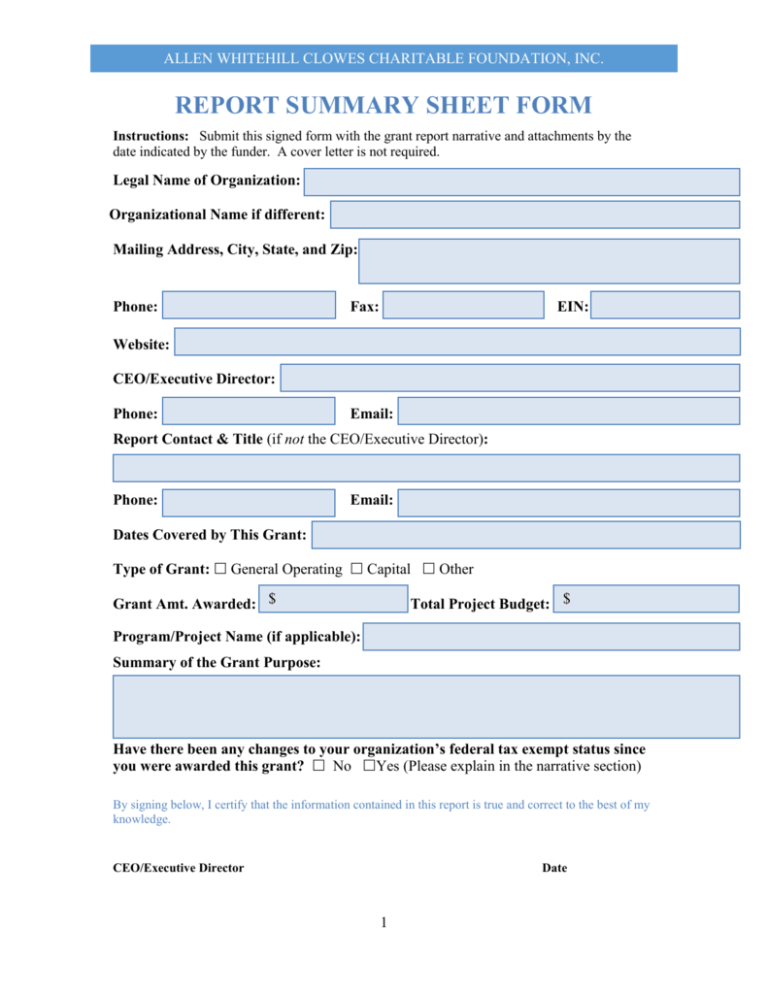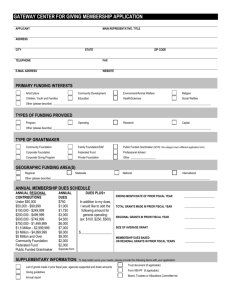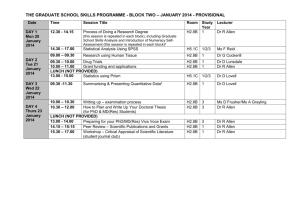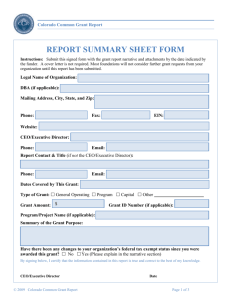Grant Report Form - Allen Whitehill Clowes Charitable Foundation, Inc.
advertisement

ALLEN WHITEHILL CLOWES CHARITABLE FOUNDATION, INC. REPORT SUMMARY SHEET FORM Instructions: Submit this signed form with the grant report narrative and attachments by the date indicated by the funder. A cover letter is not required. Legal Name of Organization: Organizational Name if different: Mailing Address, City, State, and Zip: Phone: Fax: EIN: Website: CEO/Executive Director: Phone: Email: Report Contact & Title (if not the CEO/Executive Director): Phone: Email: Dates Covered by This Grant: Type of Grant: General Operating Capital Other Grant Amt. Awarded: $ Total Project Budget: $ Program/Project Name (if applicable): Summary of the Grant Purpose: Have there been any changes to your organization’s federal tax exempt status since you were awarded this grant? No Yes (Please explain in the narrative section) By signing below, I certify that the information contained in this report is true and correct to the best of my knowledge. CEO/Executive Director Date 1 ALLEN WHITEHILL CLOWES CHARITABLE FOUNDATION, INC. GRANT REPORT NARRATIVE Instructions: The answers to the grant report narrative must relate directly to the funded grant. The answers to these four questions should not exceed three typed pages (12-point font with 1-inch margins). Also, include the HEADING provided for each question. It is not necessary to repeat the text of the questions. 1. PROGRESS AND RESULTS. Describe the progress made toward the goals and objectives as stated in the funded Grant Application. If project is completed then describe the process and its completed results. Describe key evaluative markers and results. 2. SUCCESSES AND CHALLENGES. Describe the significant successes and challenges the organization experienced related to the funded grant. 3. LESSONS LEARNED. Describe what the organization learned based upon the results, successes, and challenges reported in Questions 1 and 2. Address programmatic, evaluative, or organizational changes that will be made based upon these lessons learned. 4. ADDITIONAL INFORMATION. Share anything else that happened during the grant period that impacted the organization, either positively or negatively. 2 ALLEN WHITEHILL CLOWES CHARITABLE FOUNDATION, INC. ATTACHMENTS Instructions: Submit the following attachments along with the narrative report. Label each attachment. Please note that you may be providing financial statements for more than one year to cover the funded grant period. It is generally understood that the fiscal year(s) of the funder, nonprofit, and grant period may not be in alignment. For further clarification on any of these items, please refer to the AWWCF User’s Guide or contact the funder directly. 1. FINANCIAL STATEMENTS. (a) For all grants, submit your organization’s Statement of Financial Position (Balance Sheet) and Statement of Activities (Income and Expense Statement) for the years(s) in which the grant was used. (b) If reporting on a specific program/capital project, also submit income and expenditure information compared to the approved budget for the program/capital project. (c) If you have a more recent 990 or Audit since the time of application; also submit: Audit for most recent fiscal year completed IRS Form 990 for most recent fiscal year completed 2. ACCOMPANYING NARRATIVE (if applicable). (a) Explain any significant changes in the organization’s financial position since the grant was awarded. (b) If all funding was not expended during the grant period, explain why. (c) For program and capital grants, explain any major variances between the approved budget and the final financial statements being submitted with this report. 3. EVALUATION RESULTS. If available, provide the organization’s most recent evaluation results or findings, relevant to the funded grant. This grant report from is adapted from the Colorado Common Grant Report of 2009 and used by permission (www.coloradocommongrantforms.org/AdditionalInformation/FAQ.htm). 3 ALLEN WHITEHILL CLOWES CHARITABLE FOUNDATION, INC. USER’S GUIDE o Legal Name of Organization – This should be the exact wording from the IRS tax exempt letter. o Organization Name – The name that the organization is widely known by (or ‘doing business as’) if different from the legal name. o Mailing Address – Provide a complete and accurate mailing address for the organization. o Phone and Fax – Include the area code along with the number(s) of the organization. o EIN – The Employer Identification Number of your organization. It is sometimes referred to as a Federal Identification Number. o Website – Include the complete and accurate website address of the organization. o CEO/Executive Director – Provide the complete name and salutation of the person currently in this position. o Phone & Email – Provide the complete telephone number (including extension) and email address of the CEO/Executive Director. o Report Contact & Title – Provide this information if a person other than the CEO or Executive Director should be contacted for questions or further information. o Phone and Email – Provide the complete telephone number (including extension) and email address for the report contact. o Dates covered by this grant – Use the dates agreed upon by the organization and grantmaker. This date can often be found on the contract or award letter. Typically, this is a one-year time period, but not always. o Grant Amount Awarded– Fill in the amount of the award funded by AWWCF. This may be different than the amount asked for in the grant application and can be found on the grant award check, or the award letter. o Total Project-This is the amount of the whole operational support ask or project cost. o Project/Program Name (if applicable) – Provide the name of the project or program funded by the grant. If the organization was awarded a grant for general operating support, write ‘General Operating Support’. o Summary of the Grant Purpose – Briefly describe what the grant funding was to be used to do. o Have there been any changes to your organization’s federal tax-exempt status since you were awarded this grant? If yes, please explain. o CEO/Executive Director Signature – If there is no CEO or Executive Director, the Board president should sign the form. Indicate that change if relevant, or if the person signing is an interim CEO or Executive Director. 4 ALLEN WHITEHILL CLOWES CHARITABLE FOUNDATION, INC. ��� NARRATIVE QUESTIONS � � � Overview When writing your report, please be aware that Questions 1, 2 and 3 are intended to focus specifically on the funded grant, whether it was for general operating support, a program or project, capital, or something else. If the report is for a general operating grant, then Questions 1, 2 and 3 should be focused organization-wide covering the goals and programs outlined in the original proposal. If the report is for a special program, project, or capital grant, the information provided for Questions 1, 2 and 3 should focus on the purpose of the grant, with information about the organization as a whole included as appropriate. In Questions 1 and 2, address what happened during the period of the funded grant (looking backward). Question 3 is about forward thinking and looking ahead toward what the organization will do with what it learned during the grant period. Question 4 provides an opportunity to report any other relevant pieces of information or updates. In Question 4, you might focus on significant changes in areas such as board governance, planning, inclusiveness efforts, leadership, evaluation, etc. These could be updates related to what your organization may have shared in the original application, plus other things that have happened within the organization; for example, leadership transition, staffing changes, program cuts, or major new initiatives that have changed your organization’s focus. With this question, we are seeking to gain an understanding of what else of significance happened during the grant period. Please do not simply repeat information from your original proposal or other sections of the grant report. QUESTION 1 – PROGRESS AND RESULTS. Describe the progress made toward the goals and objectives as stated in the funded grant. Summarize the organization’s key evaluation results related to the funded grant. Rationale The purpose of this question is to report on the progress made in accomplishing the work laid out in the funded grant. In essence, did you do what you set out to do? The grantmaker is trying to learn about how the grant money was spent, as compared to the information communicated in the funded grant application. (a) In the first part of the question, specifically address the purpose of the grant that was funded and provide a brief description of the progress made. If the organization received general operating support, this answer may address a number of programs and overall agency goals. If the organization received special project or capital support, the answer will highlight very specific goals and objectives about which the organization can provide progress updates and outcomes. Please note that even if specific goals were not outlined in the original grant, it is still necessary to describe progress made over the course of the grant period. The response to this question will give the reader an understanding of the degree to which the organization met its funded goals (addressed the purpose and intent of the grant). (b) The second part of the question refers to communicating any evaluative markers that were realized during or after the funded project. For example; attendance was measured and showed a marked increase due to the ability 5 ALLEN WHITEHILL CLOWES CHARITABLE FOUNDATION, INC. to better reach the constituents through the upgrade in our technology. A good report would give statistical backing to this statement as well, if those stats are available. QUESTION 2 – SUCCESSES AND CHALLENGES. Describe the significant success and challenges the organization experienced related to the funded grant. Rationale This question provides an opportunity to share your accomplishments in the grant period, and also to discuss about any expected or unexpected obstacles encountered. The grantmaker is interested in gaining a more complete appreciation for the organization’s reality. Tips and Things to Consider: • In the response to Question 2, describe what occurred in the past – successes and challenges – and your response to them during the time period of the grant. (Please note: Question 3 is where you have the chance to describe what will be done in the future.) • Review the submitted grant proposal to refresh your memory about what your organization requested and what you have previously shared with the grantmaker in writing. Also, consider that the grant application and the approved grant may be slightly different because the grantmaker requested changes, only funded a portion of a proposal, etc. Be sure that your organization is reporting on the approved grant. • Consider any interactions you have had with your grantmaker prior to or during the grant period. Your grantmaker may have expressed interest in or concern about specific area(s) of your programs, evaluation, or operations. If so, it is a good idea to consider those area(s) when responding to this question. • This question specifically asks about successes and challenges within the context of the funded grant. If the grant was a program/project or capital request, it is possible that you have also had successes or challenges you would like to share that have occurred outside of the grant itself. If that is the case, you can share those in response to Question 4. • “Challenges” may be factors within your control or outside of your control. Perhaps something that you had not foreseen changed throughout the grant period. Thinking about internal and external factors can help enrich your answer to this question. • This is an opportunity to proactively share information about obstacles your organization has encountered. Grantmakers understand that organizations encounter challenges regularly and appreciate your honesty. Again, this is not a marketing piece but rather a report on your activities. You do not need to gloss over the challenges. • This is not the place to share what you have learned from your success or challenges – that information belongs in the response to the next question. QUESTION 3 – LESSONS LEARNED. Describe what the organization learned based upon the results, successes, and challenges reported in Question 1 and 2. Address programmatic, evaluative, or organizational changes that will be made based on these lessons learned. Rationale The purpose of this question is to provide an opportunity to share what was learned from your 6 ALLEN WHITEHILL CLOWES CHARITABLE FOUNDATION, INC. organization’s successes and/or challenges while executing the goals stated in the funded grant. This response should include actions taken, adjustments made, or plans to make changes based on lessons learned. Your answers to this question will help the AWWCF understand how your organization learns from and adapts to challenges and successes. QUESTION 4 – ADDITIONAL INFORMATION. Share anything else that happened during the grant period that impacted the organization, either positively or negatively. Rationale This question provides an opportunity to share additional information that the nonprofit was not able to share by answering the first three questions. This is your opportunity to provide important information to help AWCCF have a more complete picture of your organization. Additionally, this is an opportunity to communicate information that does not relate to the funded grant but would be helpful for AWCCF to know. ATTACHMENT/FINANCIAL SECTION Rational Nonprofits have an obligation to act as responsible stewards in managing their financial resources. They must comply with all legal financial requirements and should adhere to sound accounting principles that produce reliable financial information, ensure fiscal responsibility, and build public trust. Nonprofits should use financial resources to accomplish their missions in an effective and efficient manner, and should establish clear policies and practices to regularly monitor how funds are used. The two major purposes of financial statements are to report the financial activity and position of the organization, and to identify the costs of the organization’s principal programs and functions. Tips and Things to Consider: • The phrase “financial statements” refers to two separate documents: the Statement of Financial Position (Balance Sheet) and the Statement of Activities (Income and Expense Statement). Unless otherwise noted by the grantmaker, it is expected that you will submit these documents for any funded grant (general operating or program/project). If you are reporting on a program/project grant, it is expected that your organization will also submit information about that program/project. Many grantmakers prefer for this information to be provided in a budgetto-actual format. The actual expenses should be shown in comparison to the approved budget for the funded grant. • The financial statements required at this time will show the grantmaker how the grant funding was spent. Typically, grantmakers use this information as part of their due diligence in evaluating the impact of their own work. • Your organization is not being asked to provide a budget at this time but a budget-to-actual report. • Make sure that all documents are clearly labeled with the name of the organization and the time period covered by each document. • Some grantmakers require additional information and may have asked for an audit or IRS Form 990. Regarding audits, make sure you send a complete copy of the audit document. The 7 ALLEN WHITEHILL CLOWES CHARITABLE FOUNDATION, INC. notes and management letter are integral parts of an audit and should be included. They provide the reader with important information not available in the actual financial statements. For example, these notes and the management letter may explain how depreciation is determined, the terms of any loans, how bad debt allowances are handled, if any lawsuits are pending against the organization, etc. An audit is not complete without the accompanying notes. Leaving them out may give the appearance that an organization is not being forthcoming. Be prepared to answer questions about financial reports. If a non-finance staff member is submitting reports, s/he should understand what they are conveying in order to respond to any questions asked about them. This grant report from is adapted from the Colorado Common Grant Report of 2009 and © 2009 Colorado Common Grant Report User’s Guide used by permission (www.coloradocommongrantforms.org/AdditionalInformation/FAQ.htm). 8 ALLEN WHITEHILL CLOWES CHARITABLE FOUNDATION, INC. 9








